Marketing Management for Aldi: TOWS Analysis, Objectives, Marketing Mix, and Consumer Service
VerifiedAdded on 2023/01/12
|12
|3834
|86
AI Summary
This document discusses marketing management strategies for Aldi, including TOWS analysis, marketing objectives, marketing mix plan, and improving consumer service. It explores how Aldi can achieve success and growth in the competitive market.
Contribute Materials
Your contribution can guide someone’s learning journey. Share your
documents today.
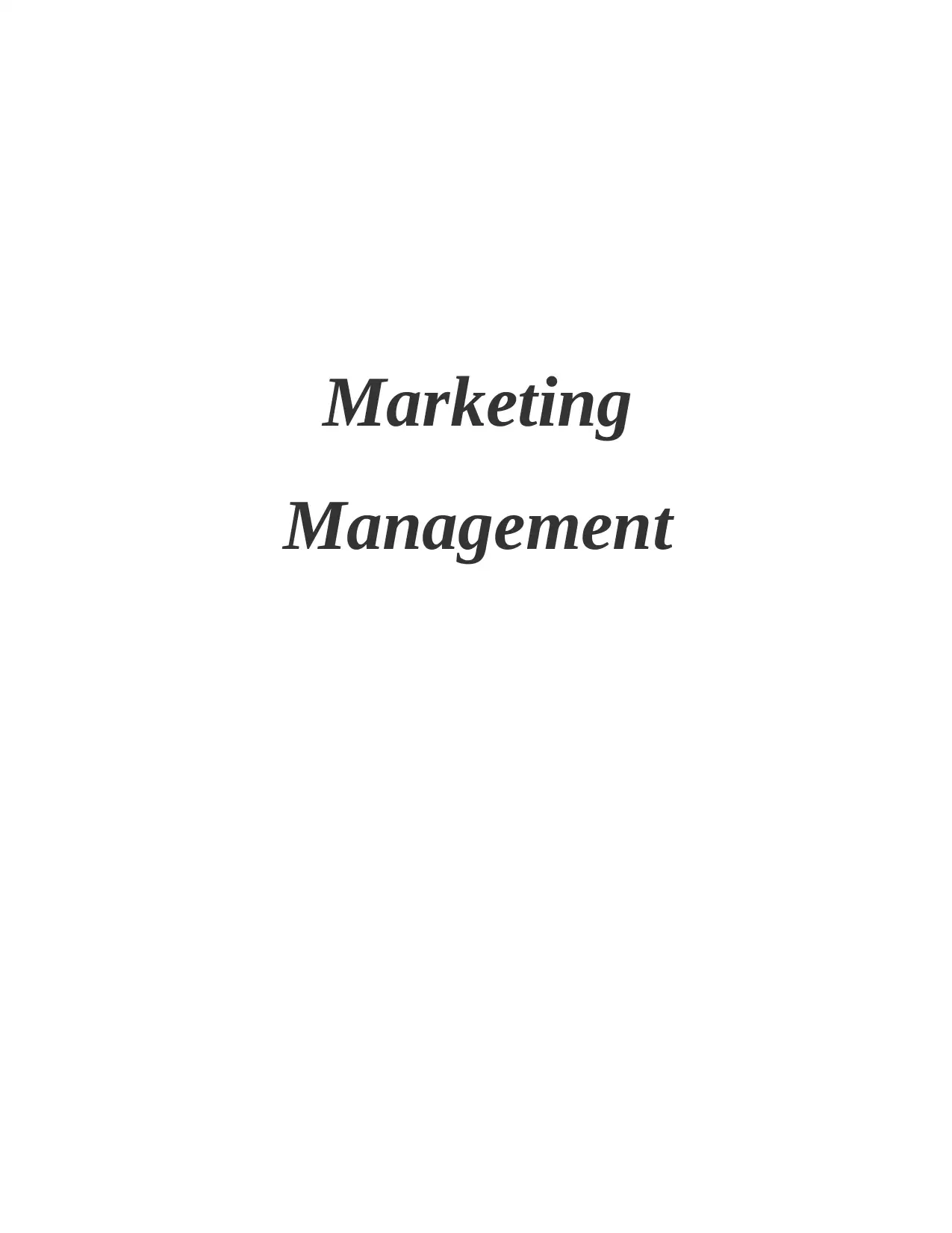
Marketing
Management
Management
Secure Best Marks with AI Grader
Need help grading? Try our AI Grader for instant feedback on your assignments.
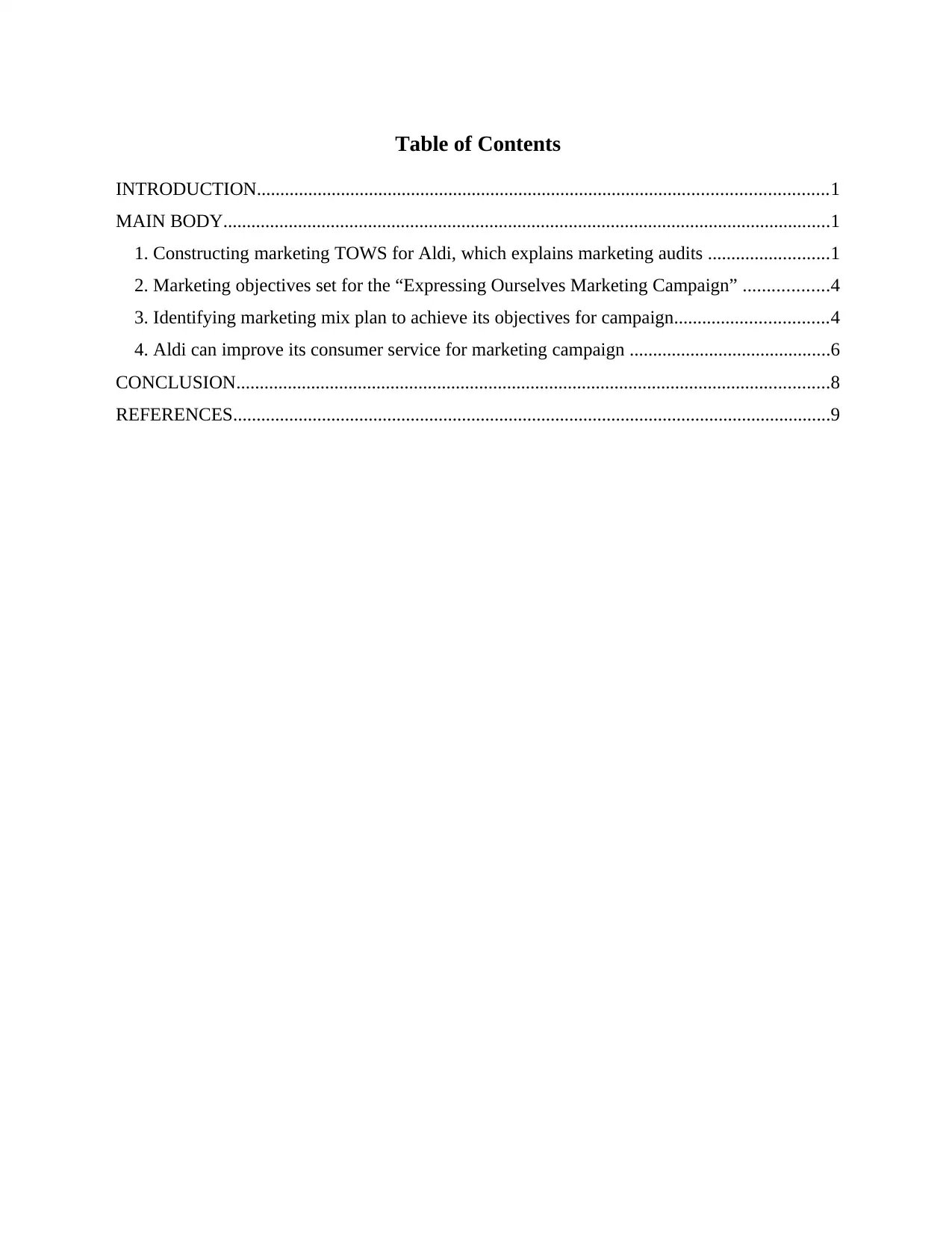
Table of Contents
INTRODUCTION..........................................................................................................................1
MAIN BODY..................................................................................................................................1
1. Constructing marketing TOWS for Aldi, which explains marketing audits ..........................1
2. Marketing objectives set for the “Expressing Ourselves Marketing Campaign” ..................4
3. Identifying marketing mix plan to achieve its objectives for campaign.................................4
4. Aldi can improve its consumer service for marketing campaign ...........................................6
CONCLUSION...............................................................................................................................8
REFERENCES................................................................................................................................9
INTRODUCTION..........................................................................................................................1
MAIN BODY..................................................................................................................................1
1. Constructing marketing TOWS for Aldi, which explains marketing audits ..........................1
2. Marketing objectives set for the “Expressing Ourselves Marketing Campaign” ..................4
3. Identifying marketing mix plan to achieve its objectives for campaign.................................4
4. Aldi can improve its consumer service for marketing campaign ...........................................6
CONCLUSION...............................................................................................................................8
REFERENCES................................................................................................................................9
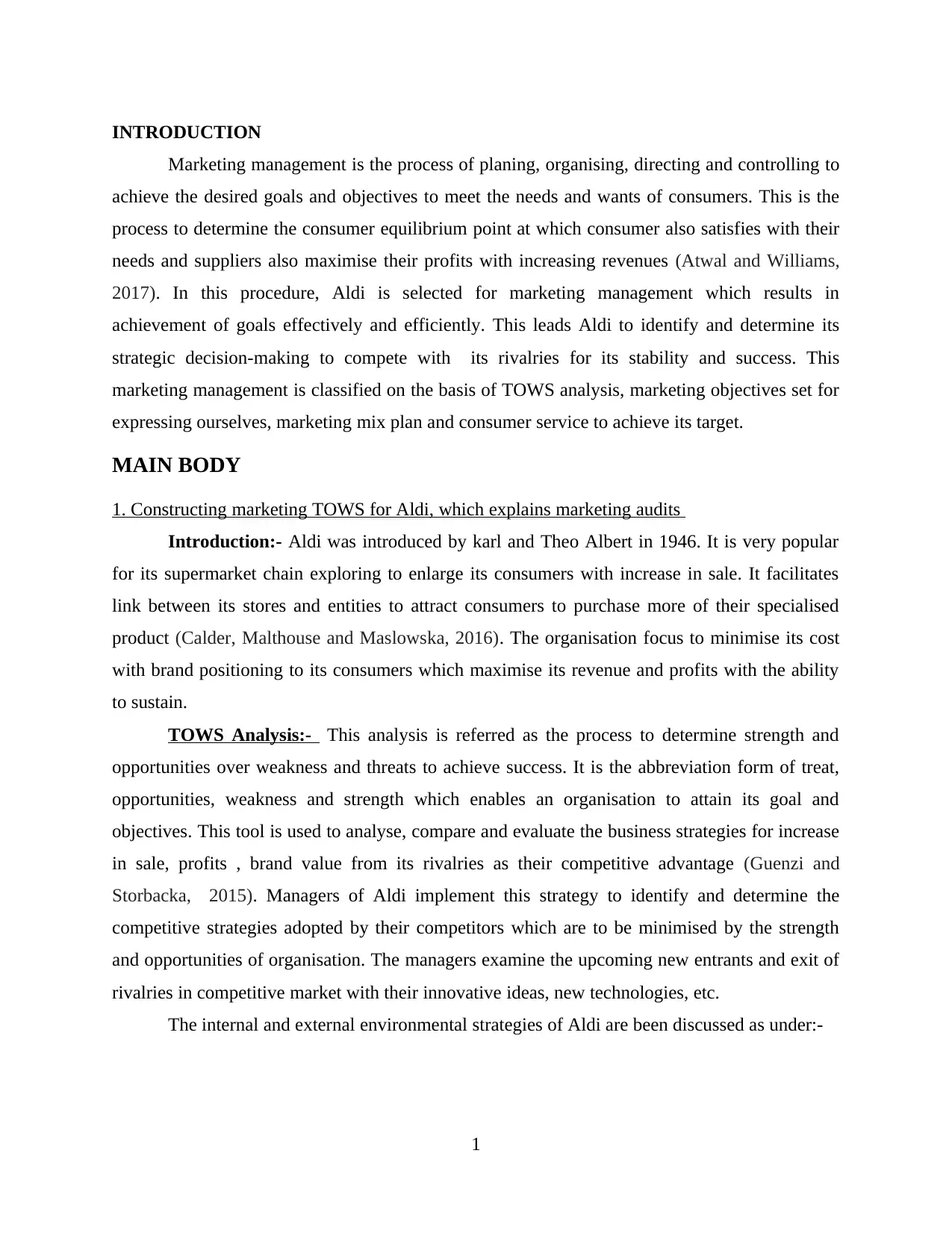
INTRODUCTION
Marketing management is the process of planing, organising, directing and controlling to
achieve the desired goals and objectives to meet the needs and wants of consumers. This is the
process to determine the consumer equilibrium point at which consumer also satisfies with their
needs and suppliers also maximise their profits with increasing revenues (Atwal and Williams,
2017). In this procedure, Aldi is selected for marketing management which results in
achievement of goals effectively and efficiently. This leads Aldi to identify and determine its
strategic decision-making to compete with its rivalries for its stability and success. This
marketing management is classified on the basis of TOWS analysis, marketing objectives set for
expressing ourselves, marketing mix plan and consumer service to achieve its target.
MAIN BODY
1. Constructing marketing TOWS for Aldi, which explains marketing audits
Introduction:- Aldi was introduced by karl and Theo Albert in 1946. It is very popular
for its supermarket chain exploring to enlarge its consumers with increase in sale. It facilitates
link between its stores and entities to attract consumers to purchase more of their specialised
product (Calder, Malthouse and Maslowska, 2016). The organisation focus to minimise its cost
with brand positioning to its consumers which maximise its revenue and profits with the ability
to sustain.
TOWS Analysis:- This analysis is referred as the process to determine strength and
opportunities over weakness and threats to achieve success. It is the abbreviation form of treat,
opportunities, weakness and strength which enables an organisation to attain its goal and
objectives. This tool is used to analyse, compare and evaluate the business strategies for increase
in sale, profits , brand value from its rivalries as their competitive advantage (Guenzi and
Storbacka, 2015). Managers of Aldi implement this strategy to identify and determine the
competitive strategies adopted by their competitors which are to be minimised by the strength
and opportunities of organisation. The managers examine the upcoming new entrants and exit of
rivalries in competitive market with their innovative ideas, new technologies, etc.
The internal and external environmental strategies of Aldi are been discussed as under:-
1
Marketing management is the process of planing, organising, directing and controlling to
achieve the desired goals and objectives to meet the needs and wants of consumers. This is the
process to determine the consumer equilibrium point at which consumer also satisfies with their
needs and suppliers also maximise their profits with increasing revenues (Atwal and Williams,
2017). In this procedure, Aldi is selected for marketing management which results in
achievement of goals effectively and efficiently. This leads Aldi to identify and determine its
strategic decision-making to compete with its rivalries for its stability and success. This
marketing management is classified on the basis of TOWS analysis, marketing objectives set for
expressing ourselves, marketing mix plan and consumer service to achieve its target.
MAIN BODY
1. Constructing marketing TOWS for Aldi, which explains marketing audits
Introduction:- Aldi was introduced by karl and Theo Albert in 1946. It is very popular
for its supermarket chain exploring to enlarge its consumers with increase in sale. It facilitates
link between its stores and entities to attract consumers to purchase more of their specialised
product (Calder, Malthouse and Maslowska, 2016). The organisation focus to minimise its cost
with brand positioning to its consumers which maximise its revenue and profits with the ability
to sustain.
TOWS Analysis:- This analysis is referred as the process to determine strength and
opportunities over weakness and threats to achieve success. It is the abbreviation form of treat,
opportunities, weakness and strength which enables an organisation to attain its goal and
objectives. This tool is used to analyse, compare and evaluate the business strategies for increase
in sale, profits , brand value from its rivalries as their competitive advantage (Guenzi and
Storbacka, 2015). Managers of Aldi implement this strategy to identify and determine the
competitive strategies adopted by their competitors which are to be minimised by the strength
and opportunities of organisation. The managers examine the upcoming new entrants and exit of
rivalries in competitive market with their innovative ideas, new technologies, etc.
The internal and external environmental strategies of Aldi are been discussed as under:-
1
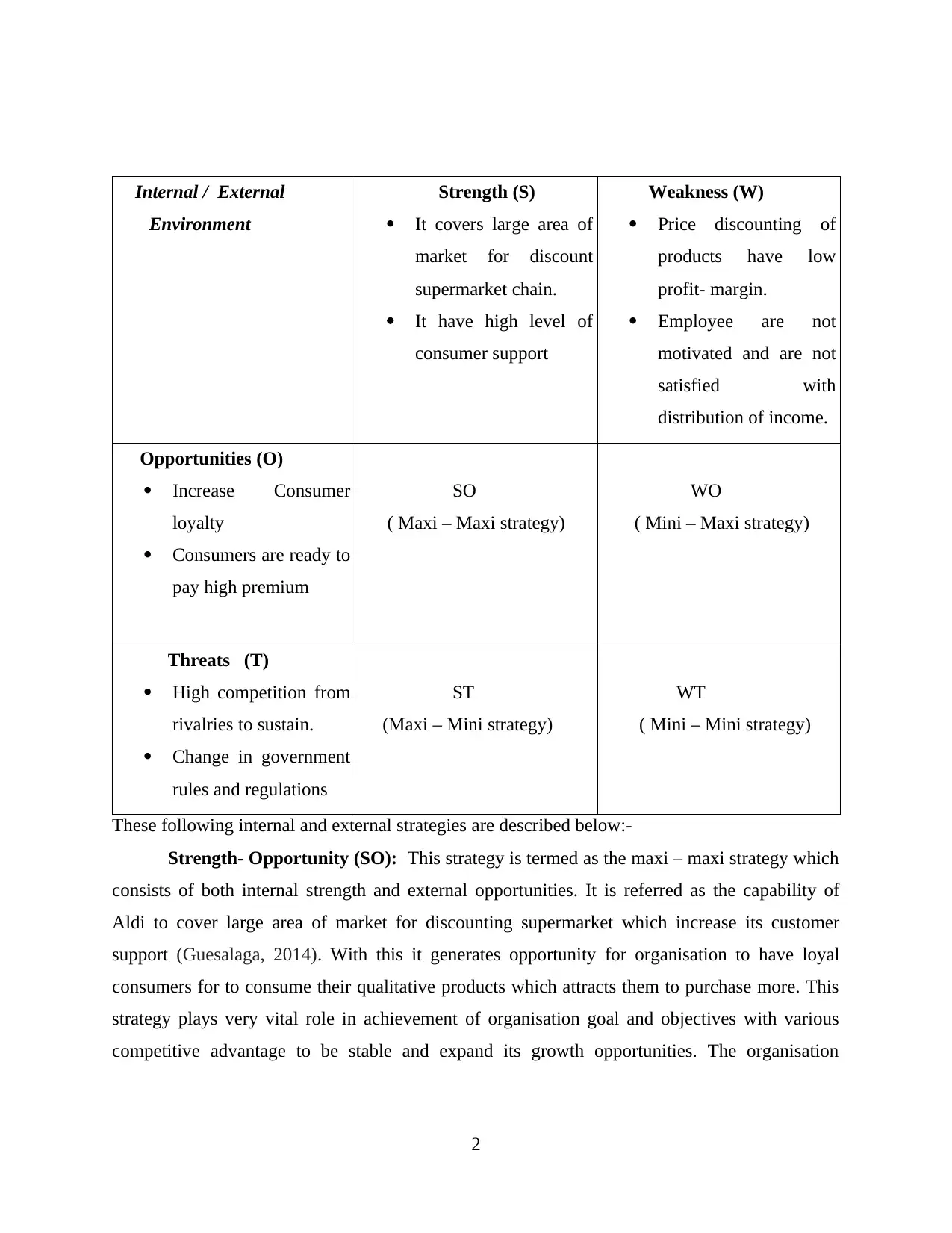
Internal / External
Environment
Strength (S)
It covers large area of
market for discount
supermarket chain.
It have high level of
consumer support
Weakness (W)
Price discounting of
products have low
profit- margin.
Employee are not
motivated and are not
satisfied with
distribution of income.
Opportunities (O)
Increase Consumer
loyalty
Consumers are ready to
pay high premium
SO
( Maxi – Maxi strategy)
WO
( Mini – Maxi strategy)
Threats (T)
High competition from
rivalries to sustain.
Change in government
rules and regulations
ST
(Maxi – Mini strategy)
WT
( Mini – Mini strategy)
These following internal and external strategies are described below:-
Strength- Opportunity (SO): This strategy is termed as the maxi – maxi strategy which
consists of both internal strength and external opportunities. It is referred as the capability of
Aldi to cover large area of market for discounting supermarket which increase its customer
support (Guesalaga, 2014). With this it generates opportunity for organisation to have loyal
consumers for to consume their qualitative products which attracts them to purchase more. This
strategy plays very vital role in achievement of organisation goal and objectives with various
competitive advantage to be stable and expand its growth opportunities. The organisation
2
Environment
Strength (S)
It covers large area of
market for discount
supermarket chain.
It have high level of
consumer support
Weakness (W)
Price discounting of
products have low
profit- margin.
Employee are not
motivated and are not
satisfied with
distribution of income.
Opportunities (O)
Increase Consumer
loyalty
Consumers are ready to
pay high premium
SO
( Maxi – Maxi strategy)
WO
( Mini – Maxi strategy)
Threats (T)
High competition from
rivalries to sustain.
Change in government
rules and regulations
ST
(Maxi – Mini strategy)
WT
( Mini – Mini strategy)
These following internal and external strategies are described below:-
Strength- Opportunity (SO): This strategy is termed as the maxi – maxi strategy which
consists of both internal strength and external opportunities. It is referred as the capability of
Aldi to cover large area of market for discounting supermarket which increase its customer
support (Guesalaga, 2014). With this it generates opportunity for organisation to have loyal
consumers for to consume their qualitative products which attracts them to purchase more. This
strategy plays very vital role in achievement of organisation goal and objectives with various
competitive advantage to be stable and expand its growth opportunities. The organisation
2
Secure Best Marks with AI Grader
Need help grading? Try our AI Grader for instant feedback on your assignments.
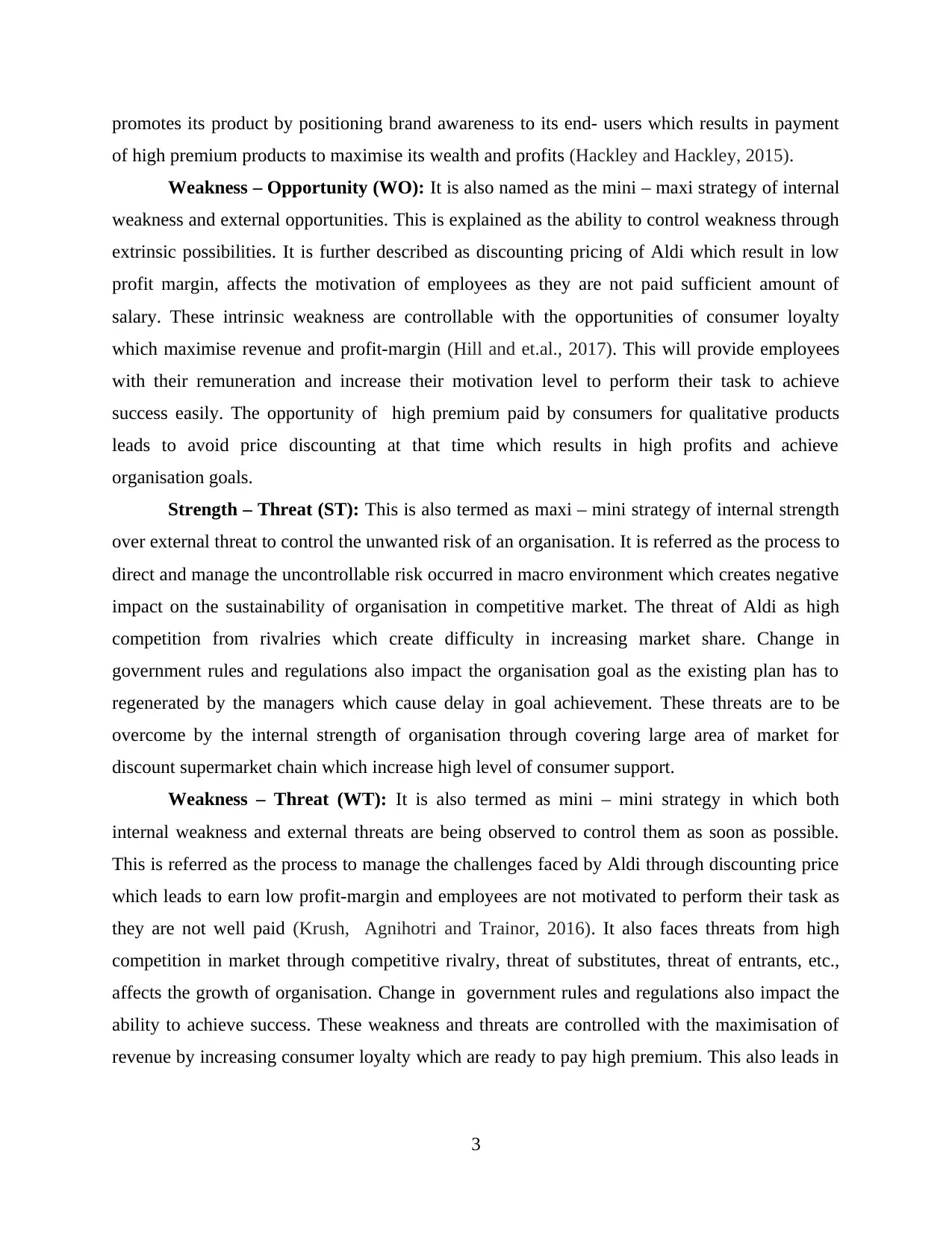
promotes its product by positioning brand awareness to its end- users which results in payment
of high premium products to maximise its wealth and profits (Hackley and Hackley, 2015).
Weakness – Opportunity (WO): It is also named as the mini – maxi strategy of internal
weakness and external opportunities. This is explained as the ability to control weakness through
extrinsic possibilities. It is further described as discounting pricing of Aldi which result in low
profit margin, affects the motivation of employees as they are not paid sufficient amount of
salary. These intrinsic weakness are controllable with the opportunities of consumer loyalty
which maximise revenue and profit-margin (Hill and et.al., 2017). This will provide employees
with their remuneration and increase their motivation level to perform their task to achieve
success easily. The opportunity of high premium paid by consumers for qualitative products
leads to avoid price discounting at that time which results in high profits and achieve
organisation goals.
Strength – Threat (ST): This is also termed as maxi – mini strategy of internal strength
over external threat to control the unwanted risk of an organisation. It is referred as the process to
direct and manage the uncontrollable risk occurred in macro environment which creates negative
impact on the sustainability of organisation in competitive market. The threat of Aldi as high
competition from rivalries which create difficulty in increasing market share. Change in
government rules and regulations also impact the organisation goal as the existing plan has to
regenerated by the managers which cause delay in goal achievement. These threats are to be
overcome by the internal strength of organisation through covering large area of market for
discount supermarket chain which increase high level of consumer support.
Weakness – Threat (WT): It is also termed as mini – mini strategy in which both
internal weakness and external threats are being observed to control them as soon as possible.
This is referred as the process to manage the challenges faced by Aldi through discounting price
which leads to earn low profit-margin and employees are not motivated to perform their task as
they are not well paid (Krush, Agnihotri and Trainor, 2016). It also faces threats from high
competition in market through competitive rivalry, threat of substitutes, threat of entrants, etc.,
affects the growth of organisation. Change in government rules and regulations also impact the
ability to achieve success. These weakness and threats are controlled with the maximisation of
revenue by increasing consumer loyalty which are ready to pay high premium. This also leads in
3
of high premium products to maximise its wealth and profits (Hackley and Hackley, 2015).
Weakness – Opportunity (WO): It is also named as the mini – maxi strategy of internal
weakness and external opportunities. This is explained as the ability to control weakness through
extrinsic possibilities. It is further described as discounting pricing of Aldi which result in low
profit margin, affects the motivation of employees as they are not paid sufficient amount of
salary. These intrinsic weakness are controllable with the opportunities of consumer loyalty
which maximise revenue and profit-margin (Hill and et.al., 2017). This will provide employees
with their remuneration and increase their motivation level to perform their task to achieve
success easily. The opportunity of high premium paid by consumers for qualitative products
leads to avoid price discounting at that time which results in high profits and achieve
organisation goals.
Strength – Threat (ST): This is also termed as maxi – mini strategy of internal strength
over external threat to control the unwanted risk of an organisation. It is referred as the process to
direct and manage the uncontrollable risk occurred in macro environment which creates negative
impact on the sustainability of organisation in competitive market. The threat of Aldi as high
competition from rivalries which create difficulty in increasing market share. Change in
government rules and regulations also impact the organisation goal as the existing plan has to
regenerated by the managers which cause delay in goal achievement. These threats are to be
overcome by the internal strength of organisation through covering large area of market for
discount supermarket chain which increase high level of consumer support.
Weakness – Threat (WT): It is also termed as mini – mini strategy in which both
internal weakness and external threats are being observed to control them as soon as possible.
This is referred as the process to manage the challenges faced by Aldi through discounting price
which leads to earn low profit-margin and employees are not motivated to perform their task as
they are not well paid (Krush, Agnihotri and Trainor, 2016). It also faces threats from high
competition in market through competitive rivalry, threat of substitutes, threat of entrants, etc.,
affects the growth of organisation. Change in government rules and regulations also impact the
ability to achieve success. These weakness and threats are controlled with the maximisation of
revenue by increasing consumer loyalty which are ready to pay high premium. This also leads in
3
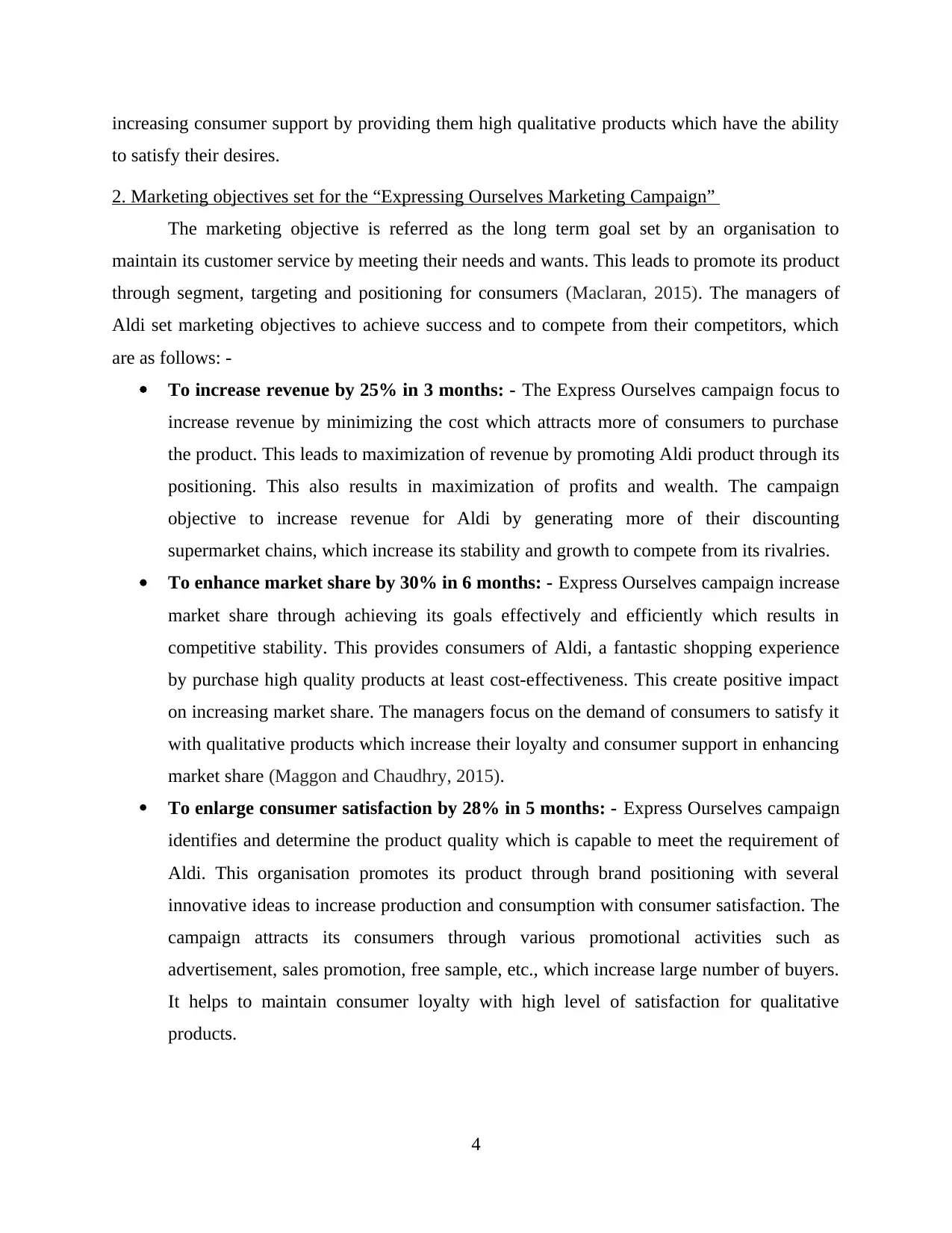
increasing consumer support by providing them high qualitative products which have the ability
to satisfy their desires.
2. Marketing objectives set for the “Expressing Ourselves Marketing Campaign”
The marketing objective is referred as the long term goal set by an organisation to
maintain its customer service by meeting their needs and wants. This leads to promote its product
through segment, targeting and positioning for consumers (Maclaran, 2015). The managers of
Aldi set marketing objectives to achieve success and to compete from their competitors, which
are as follows: -
To increase revenue by 25% in 3 months: - The Express Ourselves campaign focus to
increase revenue by minimizing the cost which attracts more of consumers to purchase
the product. This leads to maximization of revenue by promoting Aldi product through its
positioning. This also results in maximization of profits and wealth. The campaign
objective to increase revenue for Aldi by generating more of their discounting
supermarket chains, which increase its stability and growth to compete from its rivalries.
To enhance market share by 30% in 6 months: - Express Ourselves campaign increase
market share through achieving its goals effectively and efficiently which results in
competitive stability. This provides consumers of Aldi, a fantastic shopping experience
by purchase high quality products at least cost-effectiveness. This create positive impact
on increasing market share. The managers focus on the demand of consumers to satisfy it
with qualitative products which increase their loyalty and consumer support in enhancing
market share (Maggon and Chaudhry, 2015).
To enlarge consumer satisfaction by 28% in 5 months: - Express Ourselves campaign
identifies and determine the product quality which is capable to meet the requirement of
Aldi. This organisation promotes its product through brand positioning with several
innovative ideas to increase production and consumption with consumer satisfaction. The
campaign attracts its consumers through various promotional activities such as
advertisement, sales promotion, free sample, etc., which increase large number of buyers.
It helps to maintain consumer loyalty with high level of satisfaction for qualitative
products.
4
to satisfy their desires.
2. Marketing objectives set for the “Expressing Ourselves Marketing Campaign”
The marketing objective is referred as the long term goal set by an organisation to
maintain its customer service by meeting their needs and wants. This leads to promote its product
through segment, targeting and positioning for consumers (Maclaran, 2015). The managers of
Aldi set marketing objectives to achieve success and to compete from their competitors, which
are as follows: -
To increase revenue by 25% in 3 months: - The Express Ourselves campaign focus to
increase revenue by minimizing the cost which attracts more of consumers to purchase
the product. This leads to maximization of revenue by promoting Aldi product through its
positioning. This also results in maximization of profits and wealth. The campaign
objective to increase revenue for Aldi by generating more of their discounting
supermarket chains, which increase its stability and growth to compete from its rivalries.
To enhance market share by 30% in 6 months: - Express Ourselves campaign increase
market share through achieving its goals effectively and efficiently which results in
competitive stability. This provides consumers of Aldi, a fantastic shopping experience
by purchase high quality products at least cost-effectiveness. This create positive impact
on increasing market share. The managers focus on the demand of consumers to satisfy it
with qualitative products which increase their loyalty and consumer support in enhancing
market share (Maggon and Chaudhry, 2015).
To enlarge consumer satisfaction by 28% in 5 months: - Express Ourselves campaign
identifies and determine the product quality which is capable to meet the requirement of
Aldi. This organisation promotes its product through brand positioning with several
innovative ideas to increase production and consumption with consumer satisfaction. The
campaign attracts its consumers through various promotional activities such as
advertisement, sales promotion, free sample, etc., which increase large number of buyers.
It helps to maintain consumer loyalty with high level of satisfaction for qualitative
products.
4
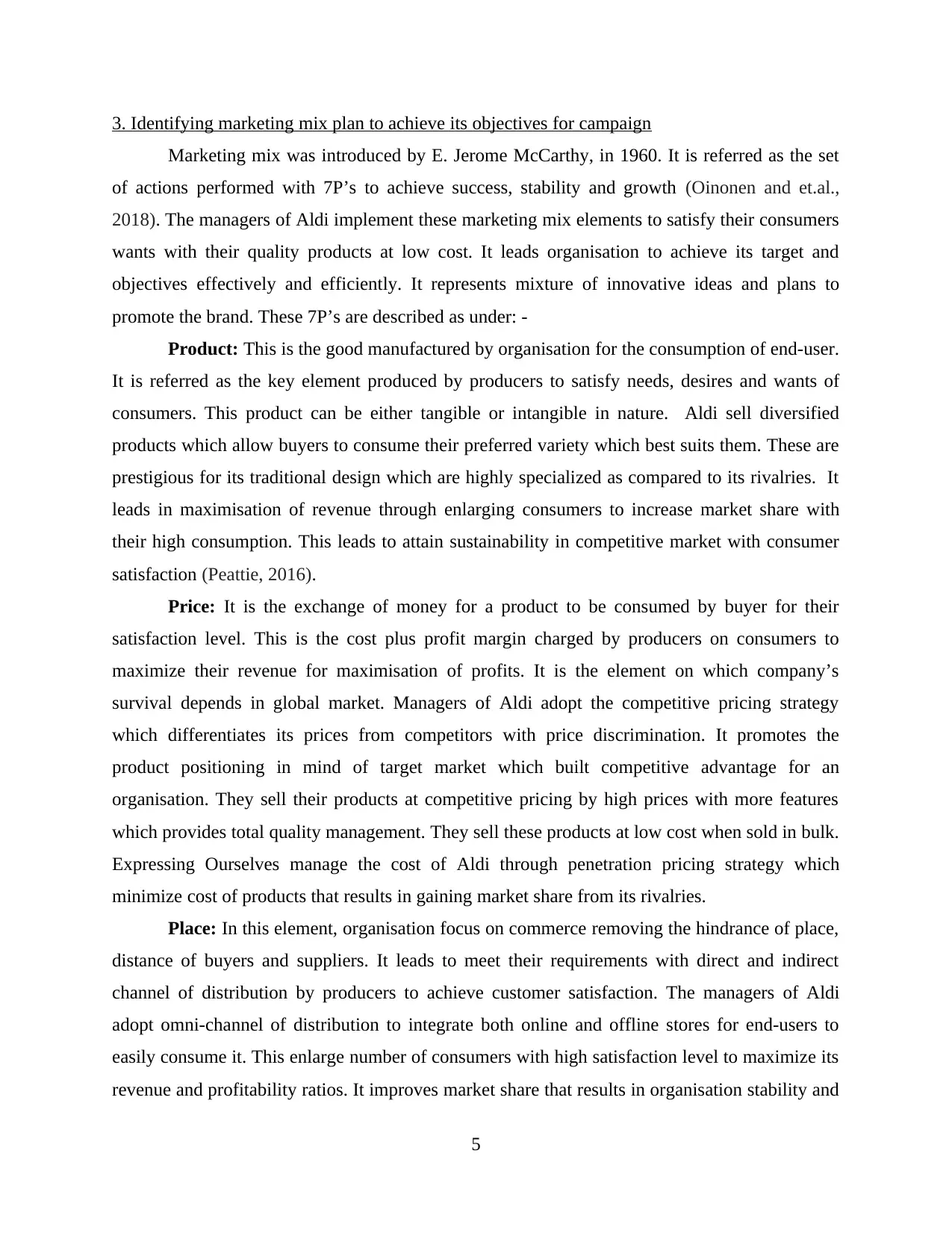
3. Identifying marketing mix plan to achieve its objectives for campaign
Marketing mix was introduced by E. Jerome McCarthy, in 1960. It is referred as the set
of actions performed with 7P’s to achieve success, stability and growth (Oinonen and et.al.,
2018). The managers of Aldi implement these marketing mix elements to satisfy their consumers
wants with their quality products at low cost. It leads organisation to achieve its target and
objectives effectively and efficiently. It represents mixture of innovative ideas and plans to
promote the brand. These 7P’s are described as under: -
Product: This is the good manufactured by organisation for the consumption of end-user.
It is referred as the key element produced by producers to satisfy needs, desires and wants of
consumers. This product can be either tangible or intangible in nature. Aldi sell diversified
products which allow buyers to consume their preferred variety which best suits them. These are
prestigious for its traditional design which are highly specialized as compared to its rivalries. It
leads in maximisation of revenue through enlarging consumers to increase market share with
their high consumption. This leads to attain sustainability in competitive market with consumer
satisfaction (Peattie, 2016).
Price: It is the exchange of money for a product to be consumed by buyer for their
satisfaction level. This is the cost plus profit margin charged by producers on consumers to
maximize their revenue for maximisation of profits. It is the element on which company’s
survival depends in global market. Managers of Aldi adopt the competitive pricing strategy
which differentiates its prices from competitors with price discrimination. It promotes the
product positioning in mind of target market which built competitive advantage for an
organisation. They sell their products at competitive pricing by high prices with more features
which provides total quality management. They sell these products at low cost when sold in bulk.
Expressing Ourselves manage the cost of Aldi through penetration pricing strategy which
minimize cost of products that results in gaining market share from its rivalries.
Place: In this element, organisation focus on commerce removing the hindrance of place,
distance of buyers and suppliers. It leads to meet their requirements with direct and indirect
channel of distribution by producers to achieve customer satisfaction. The managers of Aldi
adopt omni-channel of distribution to integrate both online and offline stores for end-users to
easily consume it. This enlarge number of consumers with high satisfaction level to maximize its
revenue and profitability ratios. It improves market share that results in organisation stability and
5
Marketing mix was introduced by E. Jerome McCarthy, in 1960. It is referred as the set
of actions performed with 7P’s to achieve success, stability and growth (Oinonen and et.al.,
2018). The managers of Aldi implement these marketing mix elements to satisfy their consumers
wants with their quality products at low cost. It leads organisation to achieve its target and
objectives effectively and efficiently. It represents mixture of innovative ideas and plans to
promote the brand. These 7P’s are described as under: -
Product: This is the good manufactured by organisation for the consumption of end-user.
It is referred as the key element produced by producers to satisfy needs, desires and wants of
consumers. This product can be either tangible or intangible in nature. Aldi sell diversified
products which allow buyers to consume their preferred variety which best suits them. These are
prestigious for its traditional design which are highly specialized as compared to its rivalries. It
leads in maximisation of revenue through enlarging consumers to increase market share with
their high consumption. This leads to attain sustainability in competitive market with consumer
satisfaction (Peattie, 2016).
Price: It is the exchange of money for a product to be consumed by buyer for their
satisfaction level. This is the cost plus profit margin charged by producers on consumers to
maximize their revenue for maximisation of profits. It is the element on which company’s
survival depends in global market. Managers of Aldi adopt the competitive pricing strategy
which differentiates its prices from competitors with price discrimination. It promotes the
product positioning in mind of target market which built competitive advantage for an
organisation. They sell their products at competitive pricing by high prices with more features
which provides total quality management. They sell these products at low cost when sold in bulk.
Expressing Ourselves manage the cost of Aldi through penetration pricing strategy which
minimize cost of products that results in gaining market share from its rivalries.
Place: In this element, organisation focus on commerce removing the hindrance of place,
distance of buyers and suppliers. It leads to meet their requirements with direct and indirect
channel of distribution by producers to achieve customer satisfaction. The managers of Aldi
adopt omni-channel of distribution to integrate both online and offline stores for end-users to
easily consume it. This enlarge number of consumers with high satisfaction level to maximize its
revenue and profitability ratios. It improves market share that results in organisation stability and
5
Paraphrase This Document
Need a fresh take? Get an instant paraphrase of this document with our AI Paraphraser
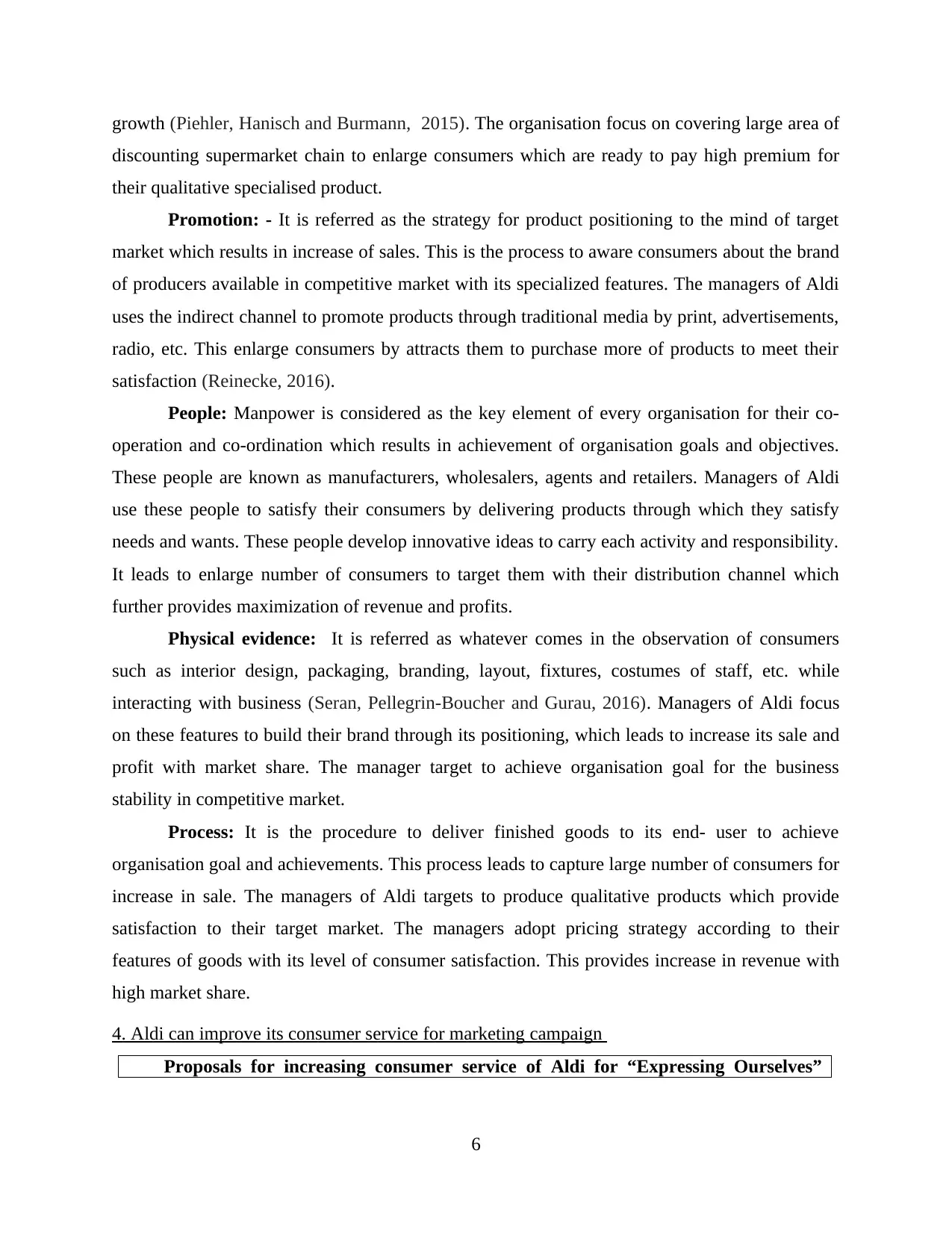
growth (Piehler, Hanisch and Burmann, 2015). The organisation focus on covering large area of
discounting supermarket chain to enlarge consumers which are ready to pay high premium for
their qualitative specialised product.
Promotion: - It is referred as the strategy for product positioning to the mind of target
market which results in increase of sales. This is the process to aware consumers about the brand
of producers available in competitive market with its specialized features. The managers of Aldi
uses the indirect channel to promote products through traditional media by print, advertisements,
radio, etc. This enlarge consumers by attracts them to purchase more of products to meet their
satisfaction (Reinecke, 2016).
People: Manpower is considered as the key element of every organisation for their co-
operation and co-ordination which results in achievement of organisation goals and objectives.
These people are known as manufacturers, wholesalers, agents and retailers. Managers of Aldi
use these people to satisfy their consumers by delivering products through which they satisfy
needs and wants. These people develop innovative ideas to carry each activity and responsibility.
It leads to enlarge number of consumers to target them with their distribution channel which
further provides maximization of revenue and profits.
Physical evidence: It is referred as whatever comes in the observation of consumers
such as interior design, packaging, branding, layout, fixtures, costumes of staff, etc. while
interacting with business (Seran, Pellegrin-Boucher and Gurau, 2016). Managers of Aldi focus
on these features to build their brand through its positioning, which leads to increase its sale and
profit with market share. The manager target to achieve organisation goal for the business
stability in competitive market.
Process: It is the procedure to deliver finished goods to its end- user to achieve
organisation goal and achievements. This process leads to capture large number of consumers for
increase in sale. The managers of Aldi targets to produce qualitative products which provide
satisfaction to their target market. The managers adopt pricing strategy according to their
features of goods with its level of consumer satisfaction. This provides increase in revenue with
high market share.
4. Aldi can improve its consumer service for marketing campaign
Proposals for increasing consumer service of Aldi for “Expressing Ourselves”
6
discounting supermarket chain to enlarge consumers which are ready to pay high premium for
their qualitative specialised product.
Promotion: - It is referred as the strategy for product positioning to the mind of target
market which results in increase of sales. This is the process to aware consumers about the brand
of producers available in competitive market with its specialized features. The managers of Aldi
uses the indirect channel to promote products through traditional media by print, advertisements,
radio, etc. This enlarge consumers by attracts them to purchase more of products to meet their
satisfaction (Reinecke, 2016).
People: Manpower is considered as the key element of every organisation for their co-
operation and co-ordination which results in achievement of organisation goals and objectives.
These people are known as manufacturers, wholesalers, agents and retailers. Managers of Aldi
use these people to satisfy their consumers by delivering products through which they satisfy
needs and wants. These people develop innovative ideas to carry each activity and responsibility.
It leads to enlarge number of consumers to target them with their distribution channel which
further provides maximization of revenue and profits.
Physical evidence: It is referred as whatever comes in the observation of consumers
such as interior design, packaging, branding, layout, fixtures, costumes of staff, etc. while
interacting with business (Seran, Pellegrin-Boucher and Gurau, 2016). Managers of Aldi focus
on these features to build their brand through its positioning, which leads to increase its sale and
profit with market share. The manager target to achieve organisation goal for the business
stability in competitive market.
Process: It is the procedure to deliver finished goods to its end- user to achieve
organisation goal and achievements. This process leads to capture large number of consumers for
increase in sale. The managers of Aldi targets to produce qualitative products which provide
satisfaction to their target market. The managers adopt pricing strategy according to their
features of goods with its level of consumer satisfaction. This provides increase in revenue with
high market share.
4. Aldi can improve its consumer service for marketing campaign
Proposals for increasing consumer service of Aldi for “Expressing Ourselves”
6
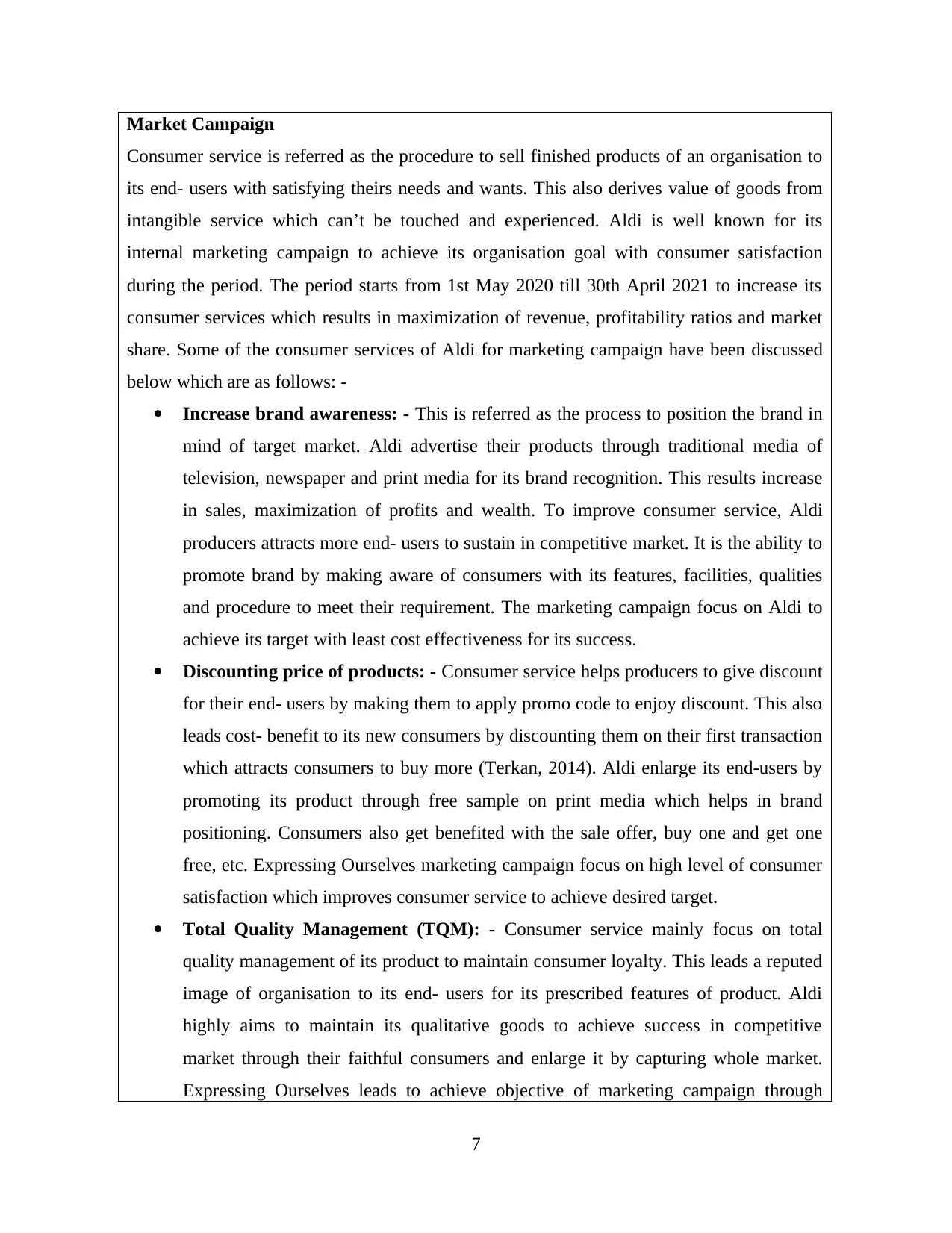
Market Campaign
Consumer service is referred as the procedure to sell finished products of an organisation to
its end- users with satisfying theirs needs and wants. This also derives value of goods from
intangible service which can’t be touched and experienced. Aldi is well known for its
internal marketing campaign to achieve its organisation goal with consumer satisfaction
during the period. The period starts from 1st May 2020 till 30th April 2021 to increase its
consumer services which results in maximization of revenue, profitability ratios and market
share. Some of the consumer services of Aldi for marketing campaign have been discussed
below which are as follows: -
Increase brand awareness: - This is referred as the process to position the brand in
mind of target market. Aldi advertise their products through traditional media of
television, newspaper and print media for its brand recognition. This results increase
in sales, maximization of profits and wealth. To improve consumer service, Aldi
producers attracts more end- users to sustain in competitive market. It is the ability to
promote brand by making aware of consumers with its features, facilities, qualities
and procedure to meet their requirement. The marketing campaign focus on Aldi to
achieve its target with least cost effectiveness for its success.
Discounting price of products: - Consumer service helps producers to give discount
for their end- users by making them to apply promo code to enjoy discount. This also
leads cost- benefit to its new consumers by discounting them on their first transaction
which attracts consumers to buy more (Terkan, 2014). Aldi enlarge its end-users by
promoting its product through free sample on print media which helps in brand
positioning. Consumers also get benefited with the sale offer, buy one and get one
free, etc. Expressing Ourselves marketing campaign focus on high level of consumer
satisfaction which improves consumer service to achieve desired target.
Total Quality Management (TQM): - Consumer service mainly focus on total
quality management of its product to maintain consumer loyalty. This leads a reputed
image of organisation to its end- users for its prescribed features of product. Aldi
highly aims to maintain its qualitative goods to achieve success in competitive
market through their faithful consumers and enlarge it by capturing whole market.
Expressing Ourselves leads to achieve objective of marketing campaign through
7
Consumer service is referred as the procedure to sell finished products of an organisation to
its end- users with satisfying theirs needs and wants. This also derives value of goods from
intangible service which can’t be touched and experienced. Aldi is well known for its
internal marketing campaign to achieve its organisation goal with consumer satisfaction
during the period. The period starts from 1st May 2020 till 30th April 2021 to increase its
consumer services which results in maximization of revenue, profitability ratios and market
share. Some of the consumer services of Aldi for marketing campaign have been discussed
below which are as follows: -
Increase brand awareness: - This is referred as the process to position the brand in
mind of target market. Aldi advertise their products through traditional media of
television, newspaper and print media for its brand recognition. This results increase
in sales, maximization of profits and wealth. To improve consumer service, Aldi
producers attracts more end- users to sustain in competitive market. It is the ability to
promote brand by making aware of consumers with its features, facilities, qualities
and procedure to meet their requirement. The marketing campaign focus on Aldi to
achieve its target with least cost effectiveness for its success.
Discounting price of products: - Consumer service helps producers to give discount
for their end- users by making them to apply promo code to enjoy discount. This also
leads cost- benefit to its new consumers by discounting them on their first transaction
which attracts consumers to buy more (Terkan, 2014). Aldi enlarge its end-users by
promoting its product through free sample on print media which helps in brand
positioning. Consumers also get benefited with the sale offer, buy one and get one
free, etc. Expressing Ourselves marketing campaign focus on high level of consumer
satisfaction which improves consumer service to achieve desired target.
Total Quality Management (TQM): - Consumer service mainly focus on total
quality management of its product to maintain consumer loyalty. This leads a reputed
image of organisation to its end- users for its prescribed features of product. Aldi
highly aims to maintain its qualitative goods to achieve success in competitive
market through their faithful consumers and enlarge it by capturing whole market.
Expressing Ourselves leads to achieve objective of marketing campaign through
7
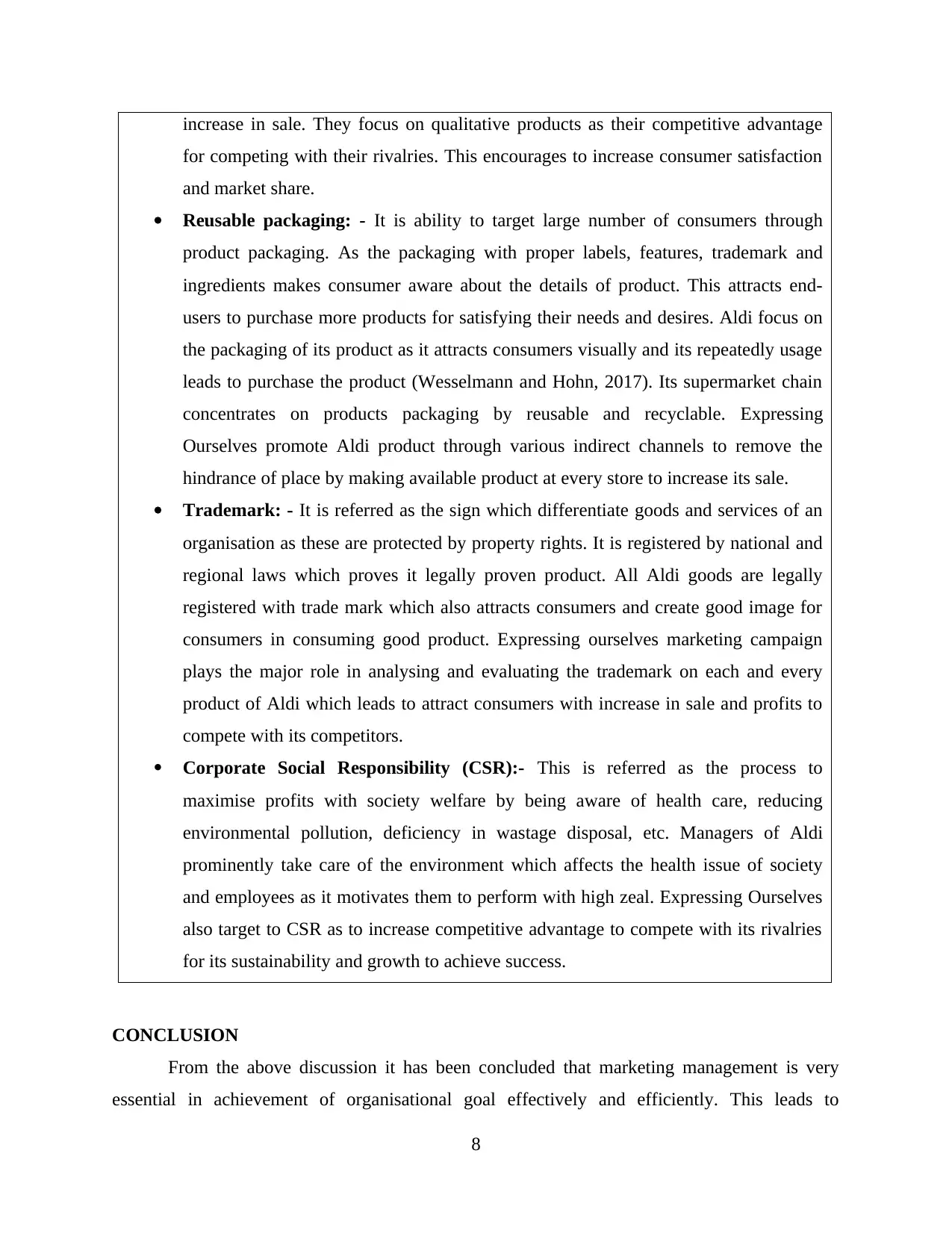
increase in sale. They focus on qualitative products as their competitive advantage
for competing with their rivalries. This encourages to increase consumer satisfaction
and market share.
Reusable packaging: - It is ability to target large number of consumers through
product packaging. As the packaging with proper labels, features, trademark and
ingredients makes consumer aware about the details of product. This attracts end-
users to purchase more products for satisfying their needs and desires. Aldi focus on
the packaging of its product as it attracts consumers visually and its repeatedly usage
leads to purchase the product (Wesselmann and Hohn, 2017). Its supermarket chain
concentrates on products packaging by reusable and recyclable. Expressing
Ourselves promote Aldi product through various indirect channels to remove the
hindrance of place by making available product at every store to increase its sale.
Trademark: - It is referred as the sign which differentiate goods and services of an
organisation as these are protected by property rights. It is registered by national and
regional laws which proves it legally proven product. All Aldi goods are legally
registered with trade mark which also attracts consumers and create good image for
consumers in consuming good product. Expressing ourselves marketing campaign
plays the major role in analysing and evaluating the trademark on each and every
product of Aldi which leads to attract consumers with increase in sale and profits to
compete with its competitors.
Corporate Social Responsibility (CSR):- This is referred as the process to
maximise profits with society welfare by being aware of health care, reducing
environmental pollution, deficiency in wastage disposal, etc. Managers of Aldi
prominently take care of the environment which affects the health issue of society
and employees as it motivates them to perform with high zeal. Expressing Ourselves
also target to CSR as to increase competitive advantage to compete with its rivalries
for its sustainability and growth to achieve success.
CONCLUSION
From the above discussion it has been concluded that marketing management is very
essential in achievement of organisational goal effectively and efficiently. This leads to
8
for competing with their rivalries. This encourages to increase consumer satisfaction
and market share.
Reusable packaging: - It is ability to target large number of consumers through
product packaging. As the packaging with proper labels, features, trademark and
ingredients makes consumer aware about the details of product. This attracts end-
users to purchase more products for satisfying their needs and desires. Aldi focus on
the packaging of its product as it attracts consumers visually and its repeatedly usage
leads to purchase the product (Wesselmann and Hohn, 2017). Its supermarket chain
concentrates on products packaging by reusable and recyclable. Expressing
Ourselves promote Aldi product through various indirect channels to remove the
hindrance of place by making available product at every store to increase its sale.
Trademark: - It is referred as the sign which differentiate goods and services of an
organisation as these are protected by property rights. It is registered by national and
regional laws which proves it legally proven product. All Aldi goods are legally
registered with trade mark which also attracts consumers and create good image for
consumers in consuming good product. Expressing ourselves marketing campaign
plays the major role in analysing and evaluating the trademark on each and every
product of Aldi which leads to attract consumers with increase in sale and profits to
compete with its competitors.
Corporate Social Responsibility (CSR):- This is referred as the process to
maximise profits with society welfare by being aware of health care, reducing
environmental pollution, deficiency in wastage disposal, etc. Managers of Aldi
prominently take care of the environment which affects the health issue of society
and employees as it motivates them to perform with high zeal. Expressing Ourselves
also target to CSR as to increase competitive advantage to compete with its rivalries
for its sustainability and growth to achieve success.
CONCLUSION
From the above discussion it has been concluded that marketing management is very
essential in achievement of organisational goal effectively and efficiently. This leads to
8
Secure Best Marks with AI Grader
Need help grading? Try our AI Grader for instant feedback on your assignments.
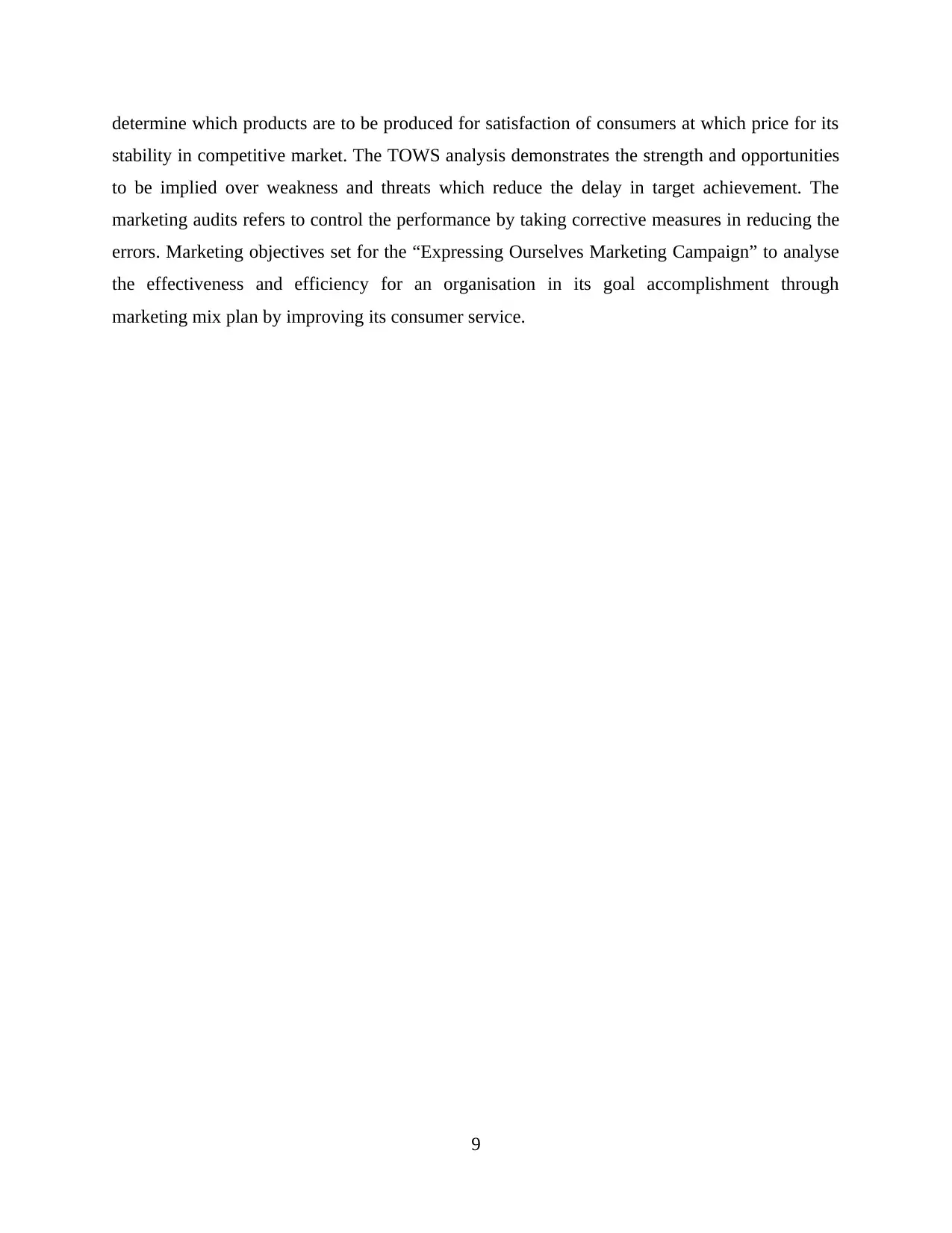
determine which products are to be produced for satisfaction of consumers at which price for its
stability in competitive market. The TOWS analysis demonstrates the strength and opportunities
to be implied over weakness and threats which reduce the delay in target achievement. The
marketing audits refers to control the performance by taking corrective measures in reducing the
errors. Marketing objectives set for the “Expressing Ourselves Marketing Campaign” to analyse
the effectiveness and efficiency for an organisation in its goal accomplishment through
marketing mix plan by improving its consumer service.
9
stability in competitive market. The TOWS analysis demonstrates the strength and opportunities
to be implied over weakness and threats which reduce the delay in target achievement. The
marketing audits refers to control the performance by taking corrective measures in reducing the
errors. Marketing objectives set for the “Expressing Ourselves Marketing Campaign” to analyse
the effectiveness and efficiency for an organisation in its goal accomplishment through
marketing mix plan by improving its consumer service.
9
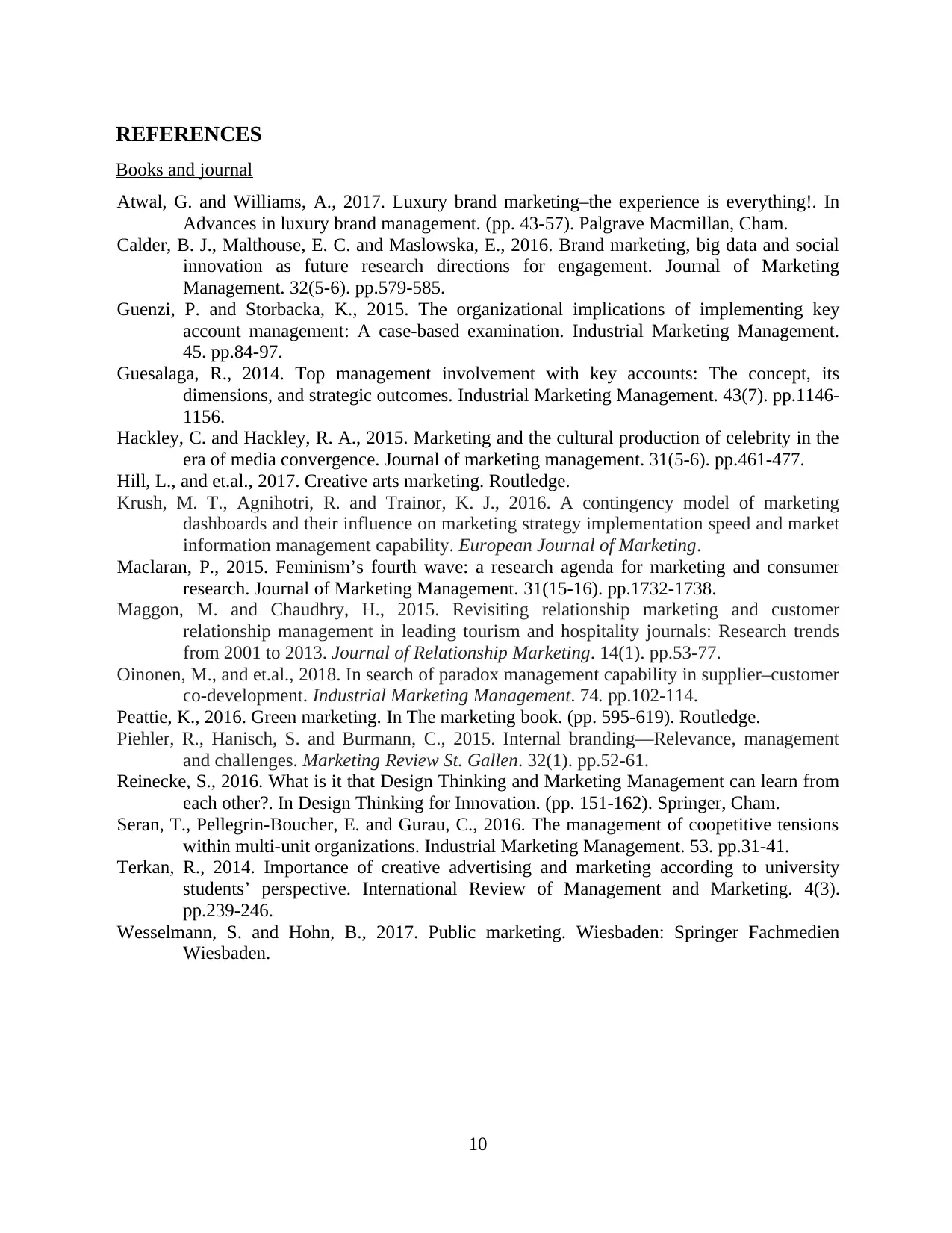
REFERENCES
Books and journal
Atwal, G. and Williams, A., 2017. Luxury brand marketing–the experience is everything!. In
Advances in luxury brand management. (pp. 43-57). Palgrave Macmillan, Cham.
Calder, B. J., Malthouse, E. C. and Maslowska, E., 2016. Brand marketing, big data and social
innovation as future research directions for engagement. Journal of Marketing
Management. 32(5-6). pp.579-585.
Guenzi, P. and Storbacka, K., 2015. The organizational implications of implementing key
account management: A case-based examination. Industrial Marketing Management.
45. pp.84-97.
Guesalaga, R., 2014. Top management involvement with key accounts: The concept, its
dimensions, and strategic outcomes. Industrial Marketing Management. 43(7). pp.1146-
1156.
Hackley, C. and Hackley, R. A., 2015. Marketing and the cultural production of celebrity in the
era of media convergence. Journal of marketing management. 31(5-6). pp.461-477.
Hill, L., and et.al., 2017. Creative arts marketing. Routledge.
Krush, M. T., Agnihotri, R. and Trainor, K. J., 2016. A contingency model of marketing
dashboards and their influence on marketing strategy implementation speed and market
information management capability. European Journal of Marketing.
Maclaran, P., 2015. Feminism’s fourth wave: a research agenda for marketing and consumer
research. Journal of Marketing Management. 31(15-16). pp.1732-1738.
Maggon, M. and Chaudhry, H., 2015. Revisiting relationship marketing and customer
relationship management in leading tourism and hospitality journals: Research trends
from 2001 to 2013. Journal of Relationship Marketing. 14(1). pp.53-77.
Oinonen, M., and et.al., 2018. In search of paradox management capability in supplier–customer
co-development. Industrial Marketing Management. 74. pp.102-114.
Peattie, K., 2016. Green marketing. In The marketing book. (pp. 595-619). Routledge.
Piehler, R., Hanisch, S. and Burmann, C., 2015. Internal branding—Relevance, management
and challenges. Marketing Review St. Gallen. 32(1). pp.52-61.
Reinecke, S., 2016. What is it that Design Thinking and Marketing Management can learn from
each other?. In Design Thinking for Innovation. (pp. 151-162). Springer, Cham.
Seran, T., Pellegrin-Boucher, E. and Gurau, C., 2016. The management of coopetitive tensions
within multi-unit organizations. Industrial Marketing Management. 53. pp.31-41.
Terkan, R., 2014. Importance of creative advertising and marketing according to university
students’ perspective. International Review of Management and Marketing. 4(3).
pp.239-246.
Wesselmann, S. and Hohn, B., 2017. Public marketing. Wiesbaden: Springer Fachmedien
Wiesbaden.
10
Books and journal
Atwal, G. and Williams, A., 2017. Luxury brand marketing–the experience is everything!. In
Advances in luxury brand management. (pp. 43-57). Palgrave Macmillan, Cham.
Calder, B. J., Malthouse, E. C. and Maslowska, E., 2016. Brand marketing, big data and social
innovation as future research directions for engagement. Journal of Marketing
Management. 32(5-6). pp.579-585.
Guenzi, P. and Storbacka, K., 2015. The organizational implications of implementing key
account management: A case-based examination. Industrial Marketing Management.
45. pp.84-97.
Guesalaga, R., 2014. Top management involvement with key accounts: The concept, its
dimensions, and strategic outcomes. Industrial Marketing Management. 43(7). pp.1146-
1156.
Hackley, C. and Hackley, R. A., 2015. Marketing and the cultural production of celebrity in the
era of media convergence. Journal of marketing management. 31(5-6). pp.461-477.
Hill, L., and et.al., 2017. Creative arts marketing. Routledge.
Krush, M. T., Agnihotri, R. and Trainor, K. J., 2016. A contingency model of marketing
dashboards and their influence on marketing strategy implementation speed and market
information management capability. European Journal of Marketing.
Maclaran, P., 2015. Feminism’s fourth wave: a research agenda for marketing and consumer
research. Journal of Marketing Management. 31(15-16). pp.1732-1738.
Maggon, M. and Chaudhry, H., 2015. Revisiting relationship marketing and customer
relationship management in leading tourism and hospitality journals: Research trends
from 2001 to 2013. Journal of Relationship Marketing. 14(1). pp.53-77.
Oinonen, M., and et.al., 2018. In search of paradox management capability in supplier–customer
co-development. Industrial Marketing Management. 74. pp.102-114.
Peattie, K., 2016. Green marketing. In The marketing book. (pp. 595-619). Routledge.
Piehler, R., Hanisch, S. and Burmann, C., 2015. Internal branding—Relevance, management
and challenges. Marketing Review St. Gallen. 32(1). pp.52-61.
Reinecke, S., 2016. What is it that Design Thinking and Marketing Management can learn from
each other?. In Design Thinking for Innovation. (pp. 151-162). Springer, Cham.
Seran, T., Pellegrin-Boucher, E. and Gurau, C., 2016. The management of coopetitive tensions
within multi-unit organizations. Industrial Marketing Management. 53. pp.31-41.
Terkan, R., 2014. Importance of creative advertising and marketing according to university
students’ perspective. International Review of Management and Marketing. 4(3).
pp.239-246.
Wesselmann, S. and Hohn, B., 2017. Public marketing. Wiesbaden: Springer Fachmedien
Wiesbaden.
10
1 out of 12
Related Documents
Your All-in-One AI-Powered Toolkit for Academic Success.
+13062052269
info@desklib.com
Available 24*7 on WhatsApp / Email
![[object Object]](/_next/static/media/star-bottom.7253800d.svg)
Unlock your academic potential
© 2024 | Zucol Services PVT LTD | All rights reserved.




